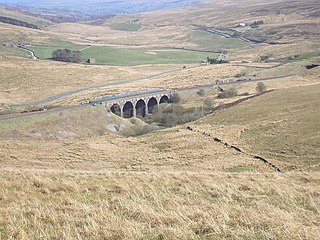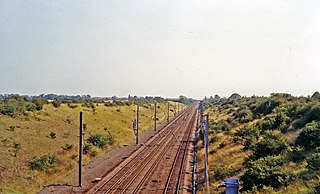
The Hawes Junction rail crash occurred at 5.49 am on 24 December 1910, just north of Lunds Viaduct between Hawes Junction and Aisgill on the Midland Railway's Settle and Carlisle main line in the North Riding of Yorkshire, England. It was caused when a busy signalman, Alfred Sutton, forgot about a pair of light engines waiting at his down (northbound) starting signal to return to their shed at Carlisle. They were still waiting there when the signalman set the road for the down Scotch express. When the signal cleared, the light engines set off in front of the express into the same block section. Since the light engines were travelling at low speed from a stand at Hawes Junction, and the following express was travelling at high speed, a collision was inevitable. The express caught the light engines just after Moorcock Tunnel near Aisgill summit in Mallerstang and was almost wholly derailed.

The Abermule train collision was a head-on collision which occurred at Abermule, Montgomeryshire, Wales on Wednesday 26 January 1921, killing 17 people. The crash arose from misunderstandings between staff which effectively over-rode the safe operation of the Electric Train Tablet system protecting the single line. A train departed carrying the wrong tablet for the section it was entering and collided with a train coming the other way.
The Charfield railway disaster was a fatal train crash which occurred on 13 October 1928 in the village of Charfield in the English county of Gloucestershire. The London, Midland and Scottish Railway (LMS) Leeds to Bristol night mail train failed to stop at the signals protecting the down refuge siding at Charfield railway station. The weather was misty, but there was not a sufficiently thick fog for the signalman at Charfield to employ fog signalmen. A freight train was in the process of being shunted from the down main line to the siding, and another train of empty goods wagons was passing through the station from the Bristol (up) direction.

The Harrow and Wealdstone rail crash was a three-train collision at Harrow and Wealdstone station in Wealdstone, Middlesex during the morning rush hour of 8 October 1952. The crash resulted in 112 deaths and 340 injuries, 88 of these being detained in hospital. It remains the worst peacetime rail crash in British history and the second deadliest overall after the Quintinshill rail disaster of 1915.

Over the latter years of the 19th and early years of the 20th centuries, Penistone in Yorkshire gained a name as an accident black-spot on Britain's railway network; indeed, it could be said to hold the title of the worst accident black-spot in the country. The main line through the town was the Woodhead route of the Manchester, Sheffield and Lincolnshire Railway between Sheffield Victoria and Manchester, London Road. The line was heavily graded with a summit some 400 yards inside the eastern portal of the Woodhead tunnel.
The Ais Gill rail accident occurred on the Settle–Carlisle line in Northwest England on 2 September 1913. Two long trains were both ascending a steep gradient with some difficulty, because their engines generated barely enough power to carry the load. When the first train stopped to build up steam pressure, the driver and fireman of the second train were distracted by maintenance routines, and failed to observe the warning signals. The collision wrecked several carriages, which were then engulfed by flammable gas, killing 16 people and injuring 38.

On the evening of 4 December 1957, two trains crashed in dense fog on the South Eastern Main Line near Lewisham in south-east London, causing the deaths of 90 people and injuring 173. An electric train to Hayes had stopped at a signal under the bridge, and the following steam train to Ramsgate crashed into it, destroying a carriage and causing the bridge to collapse onto the steam train. The bridge had to be completely removed; it was over a week before the lines under the bridge were reopened, and another month before the bridge was rebuilt and traffic allowed over it.
Two rail accidents have occurred near Castlecary, Scotland. One of these was in 1937 and one in 1968. Both events involved rear-end collisions, and caused the deaths of 35 and 2 people respectively.
The Stechford rail crash occurred on 28 February 1967 at Stechford railway station in the area of Stechford in Birmingham, England.
The Darlington rail accident occurred on the evening of 27 June 1928 when a parcels train and an excursion train collided head on at Darlington Bank Top railway station in County Durham, England. The accident was caused by the parcels train driver passing a signal at danger, due to misunderstanding the signalling layout in an unfamiliar part of the station. This accident resulted in the deaths of 25 people and the serious injury of 45 people.
There was a rail crash near Welwyn Garden City railway station in Hertfordshire, England, in 1935 which killed fourteen people, and another in 1957 with one fatality.

The Thirsk rail crash occurred on 31 July 1967 at Thirsk, Yorkshire, England on the British Rail East Coast Main Line.

The Abbots Ripton rail disaster occurred on 21 January 1876 at Abbots Ripton, then in the county of Huntingdonshire, England, on the Great Northern Railway main line, previously thought to be exemplary for railway safety. In the accident, the Special Scotch Express train from Edinburgh to London was involved in a collision, during a blizzard, with a coal train. An express travelling in the other direction then ran into the wreckage. The initial accident was caused by:

The 1984 Eccles rail crash occurred on 4 December 1984 at Eccles, Greater Manchester, when an express passenger train collided at speed with the rear of a freight train of oil tankers. The driver of the express and two passengers were killed, and 68 people were injured. The cause of the accident was determined to be that the driver of the express train had passed a signal at danger.
The Knowle and Dorridge rail crash was a fatal rail crash that occurred at Dorridge railway station in Warwickshire, England, on 15 August 1963. Three people died in the crash after a signalman's error routed a small freight train into the path of an express passenger train which slowed but could not stop before colliding with it.
The Marden rail crash occurred on 4 January 1969 near Marden, Kent, United Kingdom, when a passenger train ran into the rear of a parcels train, having passed two signals at danger. Four people were killed and 11 were injured. One person was awarded the British Empire Medal for his part in the aftermath of the collision.

The Mid-Day Scot was a British express passenger train launched in 1927 running from Edinburgh Princes Street and Glasgow Central, joining to form a train to London Euston.
The Slough rail accident happened on 16 June 1900 at Slough railway station on the Great Western Main Line when an express train from London Paddington to Falmouth Docks ran through two sets of signals at danger, and collided with a local train heading for Windsor & Eton Central. Five passengers were killed; 35 were seriously injured, and 90 complained of shock or minor injuries

The Genthin rail disaster occurred on 22 December 1939, when an express train crashed into a stationary express train in Genthin station, in today's Saxony-Anhalt state of Germany. There were up to 278 deaths, making it the worst passenger train accident in German history. It was caused by a misreading of signals, owing to one train not being equipped with automated protection, due to wartime shortages.










